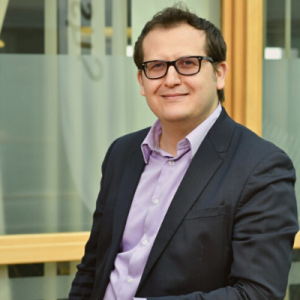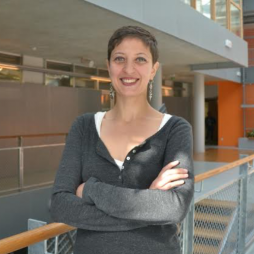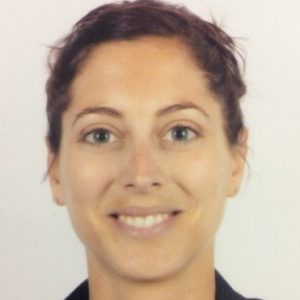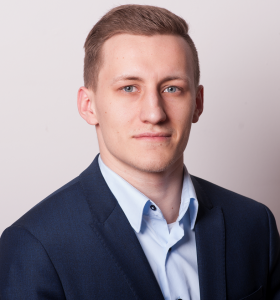International forum on Digital Twins Design & Operation (DTD&O)
Paris – December 14, 2023
Exploring the potential of systems digital twins in industrial process lifecycle management.
Welcome speech
Abdelkrim Doufene (Chairman of the conference)
Programmes & Strategy Director, IRT SystemX
From Theory to Value: Unveiling the Power of Digital Twins
Christophe Devillers
VP Digital Transformation Engineering 4.0, Safran
In this opening keynote, Christophe Devillers will share Safran's views and ideas on transitioning from theoretical frameworks to a tangible, value-generating use case. He will share his thoughts on technology integration, data-driven strategies and different industrial applications that can unlock the potential of digital twins at Safran. Through case study and cutting-edge perspectives, he will explain how his teams view Digital Twins, and will share his thoughts on harnessing the true potential of Digital Twins to create tangible value.
Digital Twins for a Resilient and Sustainable Industry
Amira Ben Hamida
Senior R&I Program Coordinator, R&D Manager, IRT SystemX
Digital Twins are key enablers for the industry of the future.
How to take benefit from this technology and make it serve the industrial technical and business know-how ?
What are the key success factors for adopting standardised and platform agnostic digital twins ?
Amira holds a PHD degree in computer Science from INSA Lyon in pervasive computing and ambient intelligence.
She is the coordinator of the industrial digital twins program at IRT SystemX and the director of multidisciplinary projects for urban and industrial digital twins in Manufactoring, Energy, and Territory Planning domains.
Since 2019 Amira is the lead of the Circular Economy and the Ecological Transition domain. She actively participates to the animation of the academic and industrial ecosystems, and the creation of French and European projects.
An Industrial Digital Twin classification framework
Emmanuelle Abisset-Chavanne
Professor , ENSAM, campus de Bordeaux / I2M
The Digital Twin paradigm is a very promising technology that can be applied to a wide range of fields and applications but is sorely lacking in a commonly accepted framework for definitions and use cases classifications. Using a bottom-up approach, this paper aims to formalize the concept and use of Digital Twins to rationalize its adoption across a range of industrial sectors.
The study is based on a large set of Digital Twin use cases collected from Digital Twin practitioners in a variety of industry verticals, from which a set of 23 use case types has been identified by the technical group "Jumeau Numérique" of the "Alliance pour l'Industrie du Futur" (AIF). This field data has been extracted, abstracted, grouped and synthesized to build an actionable Digital Twin use case classification framework comprising 23 use-case types. This work of collecting and classifying general use case types has been complemented by a study of the common aspects proposed in academic and industrial definitions of Digital Twin, to combine them in a pragmatic definition, on which the AIF group has converged to.
This work describes the resulting classification framework and illustrates it by detailing real industrial use cases, highlighting their respective added value and their application fields.
The main contributions of this work consist in proposing, from a joint industrial and academic perspective, i) the first domain-independent and industry-focused collection of use cases types of the digital twin technology, ii) a simple framework to classify the digital twin use cases and their requirements, iii) a consensual general definition of the industrial digital twin to contribute to the structuring and standardization of this very active ecosystem.
Emmanuelle Abisset-Chavanne has defended her PhD at LMT Cachan in 2012 focusing on composite laminate damage modeling. Subsequently, she conducted postdoctoral research at GeM, Ecole Centrale Nantes (2012-2013) in multi-physics modeling for thermoplastic composites processes.
From 2013 to 2019, she served as an associate professor at Ecole Centrale Nantes, specializing in multi-scale modeling of structured materials and data-based engineering. In 2019, she became a full professor at I2M, Arts et Métiers, Bordeaux-Talence, where she led research in process control and digital twins for engineering, both from the modeling and the instrumentation point of view. In the last years, she participates in different working groups on digital twins for the industry.
ATM Twin, an Air Traffic Management Digital Twin
Gabriel Mesquida-Masana
Chief Product Owner ATM Twin, Airspace Mobility Solutions, Thales
AIR Lab is a joint research lab by CAAS (Civil Aviation Authority of Singapore) and Thales created to drive ATM innovation and adoption of new technologies in Air Traffic Management. Since its inception in 2019, the AIR Lab team has grown, now hosting more than 50 members comprising ATM experts, air traffic controllers, developers, and engineers.
The ATM Twin projects a ground-breaking initiative that plays a vital role in developing future ATM capabilities. The team have been working closely on this project since March 2021, recognizing the importance of rapid innovation in the complex ATM environment.
The ATM Twin is a cloud-native platform designed for ANSPs (Air Navigation Services Providers) to prototype, analyse live and historical data and improve their operations quickly and safely. By mirroring an entire ATM system virtually, air traffic controllers can engage in what-if scenarios , optimize their workflow and try new functionalities and configurations.
The ATM twin plays a key role in advancing key topics such as Trajectory-based Operations (TBO) and in incorporating new technologies within the security and safety constraints of the ATM domain. The collaboration fosters the adoption of greener aviation practices to reduce carbon emissions such as the Continuous Descent Operations (CDO) tool that is currently under development in AIR Lab.
Continuous Descent Operations (CDO) have been prototyped in Changi Airport (Singapore, ninth busiest airport of the world, and world best airport in 2023, for 12th time). They run with live traffic in May and June 2023.
The presentation introduces the ATM Twin, explains its technical design and cloud-native approach, shows several use cases and focuses on the recent CDO trials, including a demo of live traffic, CDO advisory, and a glimpse into the conclusions of the trials by using dashboards.
Digital Twin systems and Industrial applications
Amitkumar Sawant
Future Offer Sr. Marketing Leader, Global Solutions Architect – Industry BU (India), Schneider Electric
The paper explains the digital transformation of industries through various enablers of which Digital twin is one of the most acceptable and profitable technology.
The whitepaper explains application of Digital twin technology in various industry verticals and its significance in bringing collaborative ecosystem for stakeholders to share and analyze data.
It talks about the initiatives of digital transformation or data sharing an analysis in different countries and also how standardization brings interoperability and sustainability in maintaining the the ecosystem.
Finally it throws light on few selected industrial us cases and models on the transformation can be articulated for better results.
The Journey of Making and Using A Digital Twin
Pierre-Jean Riviere
Digital Twin Solutions Leader, Airbus
Making a Digital Twin is complex, time consuming and expensive. What is the recipe for a successful story?
Based on our failures and successes, here Airbus will share the lessons learnt from different projects about how we should make a Digital Twin.
Pierre-Jean RIVIERE, Digital Twin Solutions Leader in the Airbus digital transformation programme called Digital Design Manufacturing and Services will present how to be prepared and to size a Digital Twin project.
Physics based and data enhanced digital twins for green hydrogen production
François Sanson
Head of Modelling, Optimization and Data Analysis, Lhyfe
While digital twins are becoming industry standard in mature industries such as car and aerospace industry, their use in new fields such as green hydrogen production remains vastly unexplored. Lhyfe is a European leader of renewable hydrogen, i.e., hydrogen produced by electrolysis from renewable energy sources.
The objective of this presentation is twofold : first to present a use case of successful digital twin construction and optimization in the field of green hydrogen production; secondly to present a methodology for constructing useful digital twins that are not solely the collection of massive datasets or standalone simulation codes but a full scale physics based model completely integrated to a modern data flow pipeline to get the best of the two worlds.
Consequently, we illustrate the uses cases for Lhyfe of such digital twin ranging from control optimization through model in the loop strategies to anomaly detection.
Standardization efforts for the digital twin: big picture of the ISO and IEC activities
Christophe Mouton
Data standardization expert, chair of the French mirror standardization committees AFNOR-CP IDMI of the ISO/TC 184 (Industrial) Automatisation and System integration and co-chair of the AFNOR/CN JN for ISO/IEC JTC 1/SC 41 Internet of Things and Digital Twins.
Digital twin is the new age of industrial data and modelling for products of any kinds and any size. We will highlight the latest standardization works at ISO and IEC, we will discuss how the already existing standards will help to address the Digital Twin standardization challenges.
Christophe MOUTON has been studying and developing 3D model-based applications for now 20 years at EDF. During its first 10 years at EDF R&D, he investigated the promising technologies of virtual reality, web3D and visualization of High-Performance computing simulations. Since 2011, he developed web3D-based visualization tools to allow the EDF New Nuclear engineering unit to review exceptionally large 3D CAD mock-ups of the EPR French nuclear powerplant. He participates in digital engineering standardization since 2005 and he is the chair of the AFNOR/CP IDMI French mirror committee for ISO/TC 184 and its subcommittees since 2013. He is representing EDF in several standardization bodies as expert and as a board member of the Web3D consortium. He was general chair of the ACM SIGGRAPH Web3D conference in 2012 (Los Angeles) and in 2022 (Paris)
When 'Good' is not Good Enough: Leveraging simulation in the Virtual Twin Experience for a more sustainable future
Charles Luzzato
Director of Industrial Equipment, Industry Processes SIMULIA, Dassault Systemes
It is commonly accepted that "the better is the mortal enemy of the good" (Montesquieu), a saying that is put into application numerically by the Pareto principle. Applied to engineering, one should strive to achieve the majority of the outcome with the smallest amount of effort, and not waste time and profitably on improving a "Good" design needlessly. Perhaps an infamous example of this is the RBMK reactor, in use at Chernobyl - Powerful, minimalistic and cost-effective concept - but uncommonly unstable and difficult to control. It is not possible to say whether the environmental and human catastrophe that unfolded on April 26th 1986 were directly cause by a fervent application of the Pareto principle; what can be said for certain is that the design could have been "Better" (NIKIET).
The Digital Twin helps us understand and measure the present; simulation and the Virtual Twin Experience bring us perspective and reveal what is achievable in the future. In this presentation, we will use these twins to challenge this 18th century adage and the Pareto principle - not in their fundamentals, but rather in our understanding of their implications. Looking at industrial application examples, we will show how the Virtual Twin Experience can be applied to tackle sustainability challenges, and redefine what is "Good Enough" today.
A digital twin methodology for predictive maintenance of reciprocating compressor for gas transport
Chetra Mang, Senior Research Engineer, IRT SystemX
& Grégory Jardon, Data Scientist, GRTgaz
Digital twin for predictive maintenance aims to develop and establish digital twins capable of monitoring how the state of health of industrial systems evolves. It focuses on the definition of digital twins capable of acquiring data in real time/delayed time, and processing it in order to assess the state of health of the industrial system. Furthermore, the digital twin must be able to predict and optimize how the lifetime of the physical system evolves, based on the different health indicators identified.
The presented work targets the GRTgaz's use-case which deals with circumvention of the system failures and injection stop of the distribution network toward the transport network. To do so, the reciprocating compressors need to be efficiently maintained. The digital twin methodology is proposed to establish the maintenance policies by using the digital twin coupled between sensor data and physical simulation. The data acquisition and physical model methodology have been proposed. The primary results of physical modeling are presented.
Model-Based Development of Variant-Rich Systems Using Digital Twins
Heinrich Wagner
Scientific Assistant, University of Applied Sciences Munich
The utilization of digital twins in the realm of system development and operation has evolved into an undoubtedly successful paradigm for mitigating developmental timeline constraints and augmenting the functional spectrum of a given system. However, the establishment of the digital twin necessitates bespoke developmental processes that must be inherently aligned with the intricacies of the system being supported.
This work introduces an approach which, firstly, leverages an identical repository of developmental artifacts for both the target system under development and its corresponding digital twin, and secondly, adeptly manages the variability inherent in application scenarios, system architecture, and the structure of the digital twin through the application of Product Line Engineering principles.
From hybrid (data & physical) models to decision support tools
Jean-Michel Ghidaglia
CEO of deepika.ai & Professor at UM6P
Hybrid data-physics models rely both on the most faithful possible representation of physical phenomena and on statistics and learning from large observation databases. These models are now leaving R&D centers to lead to decision support tools made available to operational staff in the industry.
Systemic Digital Twins to Optimize Industrial Systems Strategy and Operations
Daniel Krob
CEO, Systemic Intelligence
We will present the notion of a systemic digital twin which ensures continuity between model-driven system engineering and digital & predictive simulation. We will illustrate this approach with a case study.
Daniel Krob is one of the world's leading specialists in the modeling of complex systems. Former holder of the chair of complex systems engineering and former professor at the Ecole Polytechnique (2001-2019), he currently chairs the CESAMES group, specializing in systems architecture & engineering, of which Systemic Intelligence is a part, which is developing a solution original. of systemic digital twin. Daniel Krob is the author of more than a hundred scientific articles and works. In particular, he invented the CESAM (CESAMES Systems Architecting Method) method of model-driven system engineering which has been distributed to more than 10,000 engineers and deployed on more than 2,000 industrial systems development projects around the world. He is also a member of the International Council on Systems Engineering (INCOSE) since 2014.













